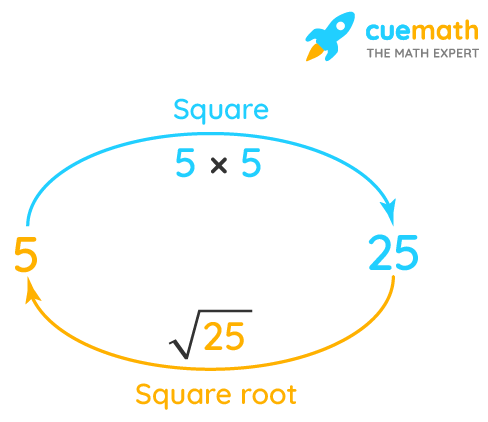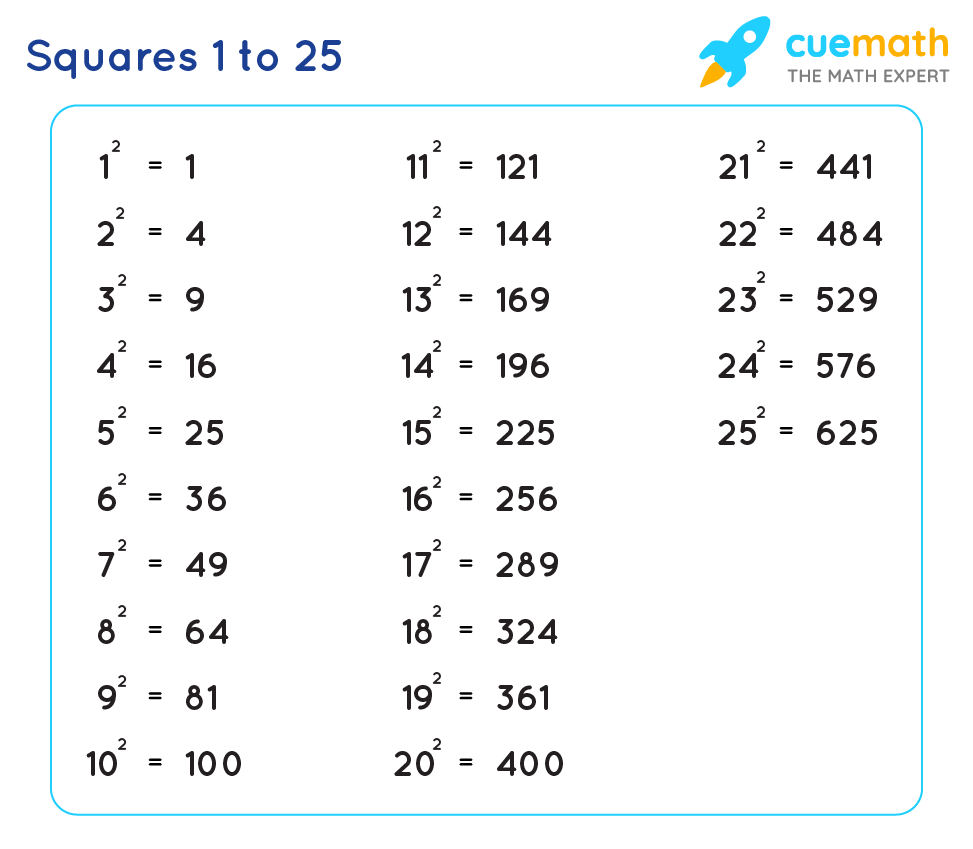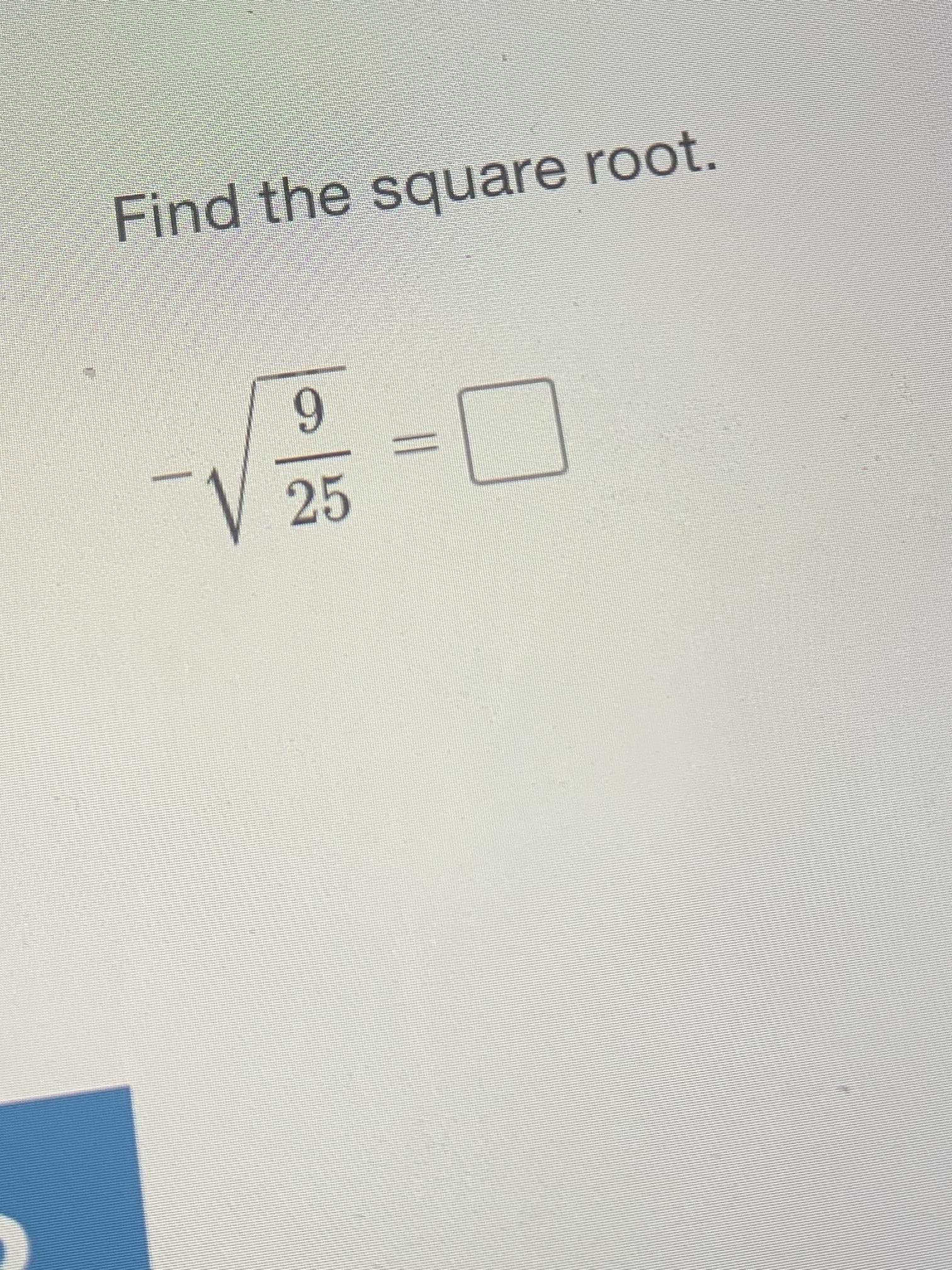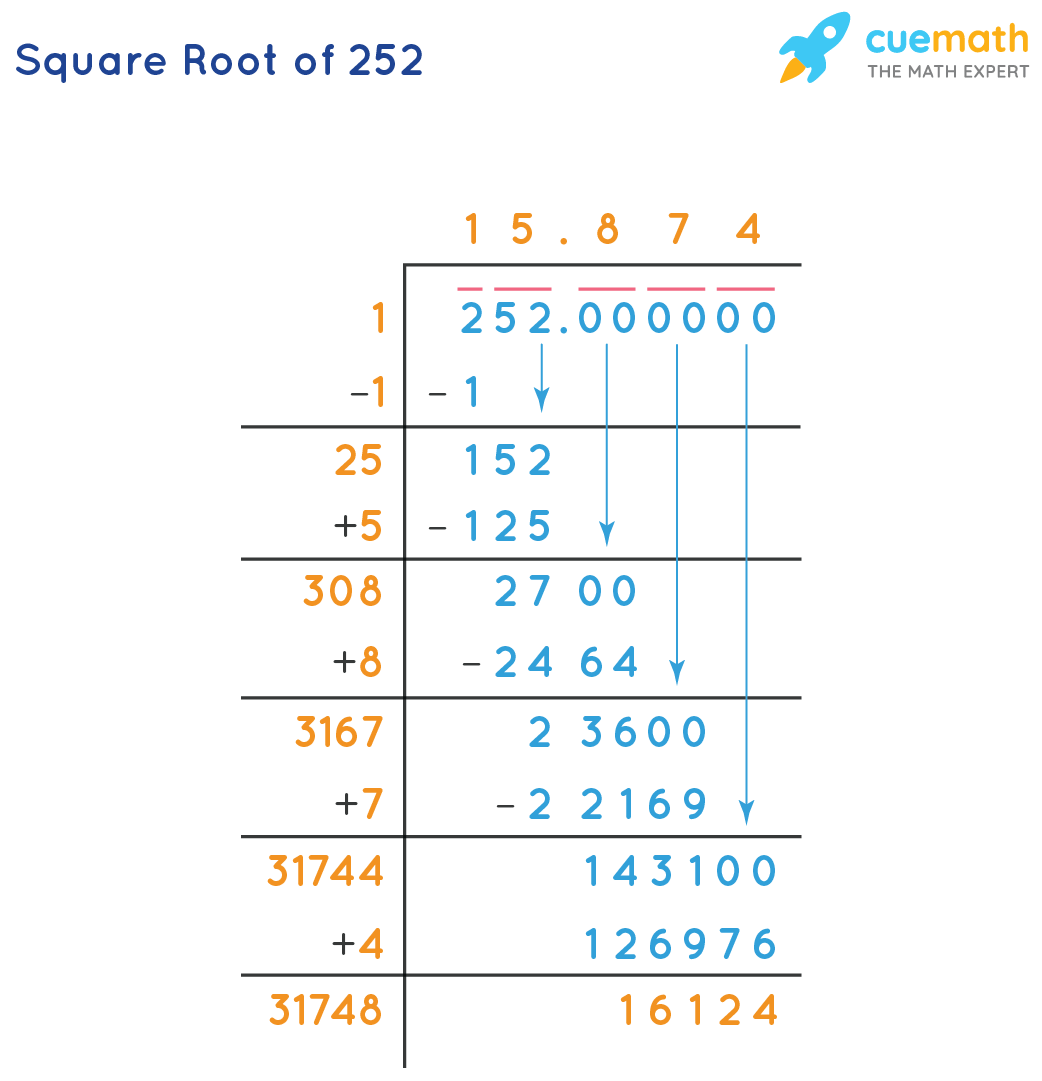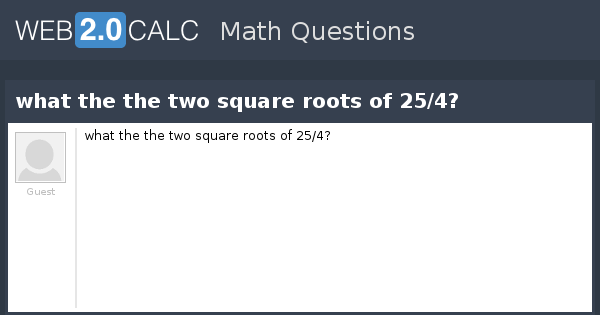Topic square root of 225 by division method: Discover the simple and efficient division method to find the square root of 225. This step-by-step guide will walk you through the process, making it easy to understand and apply. Perfect for students and math enthusiasts, this method breaks down the problem into manageable steps, ensuring clarity and accuracy in finding the square root.
Table of Content
- Square Root of 225 by Division Method
- Introduction
- Understanding the Division Method
- Step-by-Step Process
- Writing 225 in Pairs
- Finding the Largest Number for the First Pair
- Subtracting and Bringing Down the Next Pair
- Forming the New Divisor
- Finding the Correct Digit for the Quotient
- Subtracting to Get the Remainder
- Completing the Division
- Result Interpretation
- Example Problems
- Tips and Tricks
- Common Mistakes to Avoid
- Conclusion
- YOUTUBE: Xem video hướng dẫn cách tìm căn bậc hai của 225 bằng phương pháp chia dài. Video giải thích chi tiết từng bước một cách rõ ràng và dễ hiểu.
Square Root of 225 by Division Method
The division method is a systematic way to find the square root of a number by pairing digits and performing long division. Here is the step-by-step process to find the square root of 225 using this method:
Steps to Find the Square Root of 225
-
Write 225 in pairs of digits starting from the unit place. Place a bar over each pair of digits. In this case, we have two pairs: 2 and 25.
-
Find the largest number whose square is less than or equal to the first pair. Here, the first pair is 2. The largest number is 1 (since \(1^2 = 1\) and \(2^2 = 4\)).
Write 1 as the quotient and also as the divisor. Subtract 1 from 2 to get the remainder 1.
-
Bring down the next pair (25) to the right of the remainder. This makes the new dividend 125.
-
Double the quotient (which is 1) to get 2 and place it as the new divisor's tens place. Now, find a number which when placed in the unit's place of the new divisor and multiplied by the new divisor gives a product less than or equal to 125.
In this case, the number is 5 (since \(25 \times 5 = 125\)). Write 5 next to the quotient (making it 15) and also next to the new divisor (making it 25).
-
Subtract 125 from 125 to get a remainder of 0. Since the remainder is 0 and there are no more pairs to bring down, the division is complete.
Result
The square root of 225 is 15.
Visual Representation
| 1 | ||
| 1 | 225 | |
| 1 | - | 1 |
| 125 | ||
| 2 | 5 | |
| 25 | x | 5 |
| - | 125 | |
| 0 | ||
The quotient 15 is the square root of 225.

READ MORE:
Introduction
The division method is a powerful and methodical approach to finding the square root of a number. This technique is especially useful for numbers that are not perfect squares and can be applied to any positive number. In this guide, we will focus on finding the square root of 225 using the division method. This method breaks down the problem into manageable steps, ensuring accuracy and understanding. By the end of this guide, you will be able to apply the division method confidently to find the square root of any number.
Let's begin by understanding the core steps involved in the division method:
-
Pairing the Digits: Begin by pairing the digits of the number from right to left. For 225, we have two pairs: 2 and 25.
-
Finding the Largest Square: Identify the largest number whose square is less than or equal to the first pair. Write this number as the divisor and the quotient. For the first pair (2), the largest number is 1 because \(1^2 = 1\) and \(2^2 = 4\).
-
Subtraction and Bringing Down: Subtract the square of the divisor from the first pair and bring down the next pair to the right of the remainder. In this case, subtracting 1 from 2 gives us 1, and bringing down 25 gives us 125.
-
Forming a New Divisor: Double the current quotient and use it as the new divisor's tens place. Find the appropriate digit for the unit's place that, when multiplied by the new divisor, gives a product less than or equal to the new dividend. For 125, the new divisor starts with 2 (double of 1), and the correct digit is 5, making the new divisor 25.
-
Final Subtraction: Multiply the new divisor by the new quotient digit and subtract from the current dividend. Continue this process until the remainder is zero or until you reach the desired precision. Here, \(25 \times 5 = 125\), and subtracting gives a remainder of 0.
By following these steps, you will determine that the square root of 225 is 15. This method ensures a clear and systematic approach, making complex calculations easier and more accurate.
Understanding the Division Method
The division method is a structured and logical approach to finding the square root of a number. It involves breaking down the number into smaller, more manageable parts and systematically solving for the square root. Here, we will explain the division method in detail, using the number 225 as an example. This method ensures accuracy and helps build a strong foundation for understanding square roots.
-
Pairing the Digits: Begin by pairing the digits of the number from right to left. For the number 225, we form two pairs: 2 and 25.
- 225 → (2)(25)
-
Finding the Largest Square: Identify the largest number whose square is less than or equal to the first pair. Write this number as the divisor and the quotient. For the first pair (2), the largest number is 1 because \(1^2 = 1\) and \(2^2 = 4\).
- Quotient: 1
- Divisor: 1
-
Subtraction and Bringing Down: Subtract the square of the divisor from the first pair and bring down the next pair to the right of the remainder. In this case, subtracting 1 from 2 gives us 1, and bringing down 25 gives us 125.
- 2 - 1 = 1
- Bring down 25 → 125
-
Forming a New Divisor: Double the current quotient and use it as the new divisor's tens place. Find the appropriate digit for the unit's place that, when multiplied by the new divisor, gives a product less than or equal to the new dividend. For 125, the new divisor starts with 2 (double of 1), and the correct digit is 5, making the new divisor 25.
- Double of 1 = 2
- New divisor: 25
- 125 ÷ 25 = 5
-
Final Subtraction: Multiply the new divisor by the new quotient digit and subtract from the current dividend. Continue this process until the remainder is zero or until you reach the desired precision. Here, \(25 \times 5 = 125\), and subtracting gives a remainder of 0.
- 25 x 5 = 125
- 125 - 125 = 0
By following these steps, you will determine that the square root of 225 is 15. This methodical approach ensures clarity and accuracy, making it easier to understand and apply to other numbers.
Step-by-Step Process
Finding the square root of 225 using the division method involves a series of detailed and systematic steps. Below, we outline each step to ensure clarity and accuracy in the process:
-
Pairing the Digits: Start by pairing the digits of 225 from right to left. Place a bar over each pair. In this case, we have two pairs: 2 and 25.
- 225 → (2)(25)
-
Finding the Largest Square: Identify the largest number whose square is less than or equal to the first pair (2). This number is 1 because \(1^2 = 1\) and \(2^2 = 4\).
- Write 1 as the quotient and also as the divisor.
- Subtract 1 from 2 to get the remainder 1.
-
Bringing Down the Next Pair: Bring down the next pair (25) to the right of the remainder. This makes the new dividend 125.
- New dividend: 125
-
Forming the New Divisor: Double the current quotient (which is 1) to get 2 and place it as the new divisor's tens place. Now, find a number which, when placed in the unit's place of the new divisor and multiplied by the new divisor, gives a product less than or equal to 125.
- The number is 5 because \(25 \times 5 = 125\).
- Write 5 next to the quotient (making it 15) and also next to the new divisor (making it 25).
-
Final Subtraction: Multiply the new divisor (25) by the new quotient digit (5) and subtract from the current dividend (125). Since \(25 \times 5 = 125\), the remainder is 0.
- 125 - 125 = 0
By following these steps, you will find that the square root of 225 is 15. This systematic approach ensures accuracy and helps in understanding the process of finding square roots using the division method.
Writing 225 in Pairs
To begin the division method for finding the square root of 225, the first step is to write the number in pairs of digits, starting from the right. This process helps in simplifying the calculation and is crucial for the division method.
-
Step 1: Identify the Number of Digits: Determine the total number of digits in the number 225. In this case, 225 has three digits.
-
Step 2: Pair the Digits from Right to Left: Starting from the right, group the digits into pairs. If the number has an odd number of digits, the leftmost group will contain only one digit.
- 225 → The first pair is 25, and the remaining digit is 2.
-
Step 3: Write the Pairs: Write the number with bars over each pair to clearly separate them for the division process.
- 225 can be written as: \( \overline{2} \overline{25} \)
By writing the number 225 in pairs, we have \(\overline{2}\) and \(\overline{25}\). This structured representation sets the stage for the next steps in the division method, making it easier to handle the calculation systematically.

Finding the Largest Number for the First Pair
After writing the number 225 in pairs, the next step in the division method is to find the largest number whose square is less than or equal to the first pair of digits. This forms the basis for our initial quotient and divisor.
-
Step 1: Identify the First Pair: Look at the first pair of digits on the left. For 225, the first pair is 2.
- First pair: 2
-
Step 2: Find the Largest Square: Determine the largest number whose square is less than or equal to the first pair (2).
- \(1^2 = 1\)
- \(2^2 = 4\) (This is greater than 2)
-
Step 3: Select the Largest Number: The largest number whose square is less than or equal to 2 is 1, because \(1^2 = 1\).
- Largest number: 1
-
Step 4: Write the Quotient and Divisor: Write this number as the initial quotient and divisor.
- Quotient: 1
- Divisor: 1
-
Step 5: Subtract the Square: Subtract the square of the divisor from the first pair. This forms the remainder, which will be used in the next step.
- 2 - 1 = 1 (remainder)
By following these steps, we have determined that the largest number whose square is less than or equal to the first pair (2) is 1. This forms the initial quotient and divisor, setting the stage for the subsequent steps in the division method to find the square root of 225.
Subtracting and Bringing Down the Next Pair
Once we have found the largest number for the first pair and performed the initial subtraction, the next step in the division method is to bring down the next pair of digits. This process continues the calculation towards finding the square root of 225.
-
Step 1: Perform the Initial Subtraction: Subtract the square of the divisor from the first pair to get the remainder. For 225, after finding the largest number (1) and using it as the divisor:
- \(2 - 1^2 = 2 - 1 = 1\)
-
Step 2: Bring Down the Next Pair: Bring down the next pair of digits to the right of the remainder. In this case, bring down 25 to the right of 1, forming a new number.
- New number: 125 (formed by bringing down 25 to the right of the remainder 1)
-
Step 3: Write the New Dividend: This new number (125) becomes the new dividend for the next step in the division method.
- New dividend: 125
By following these steps, we have successfully brought down the next pair of digits, forming a new dividend of 125. This new dividend will be used in the subsequent steps to continue the division process and ultimately find the square root of 225.
Forming the New Divisor
After bringing down the next pair of digits to form a new dividend, the next step in the division method is to form a new divisor. This involves updating the divisor based on the current quotient and finding the next digit of the quotient. Here is a detailed step-by-step process:
-
Step 1: Double the Current Quotient: Take the current quotient and double it. This forms the starting part of the new divisor. For example, if the current quotient is 1:
- Current quotient: 1
- Double of 1: 2
-
Step 2: Determine the Next Digit: Find a digit that, when placed next to the doubled quotient, forms a new divisor. This new divisor, when multiplied by the same digit, should result in a product less than or equal to the new dividend (125).
- Form the new divisor by placing a digit next to 2: 20_
- Determine the digit: 5 (since \(25 \times 5 = 125\))
-
Step 3: Form the Complete New Divisor: Place the determined digit both in the new divisor and as the next digit in the quotient.
- New divisor: 25
- Updated quotient: 15
By following these steps, we have formed the new divisor, which is 25. This new divisor is used in the next multiplication and subtraction steps to continue the process of finding the square root of 225.
Finding the Correct Digit for the Quotient
Once we have formed the new divisor, we proceed to find the correct digit for the quotient:
- Compare the divisor (formed by bringing down the next pair of digits) with the part of the dividend that remains after performing the subtraction in the previous step.
- Find the largest digit such that when this digit is multiplied by the entire divisor, the result is less than or equal to the remaining part of the dividend.
- This digit becomes the next digit in the quotient.
- Subtract the product of this digit and the entire divisor from the remaining part of the dividend to find the new remainder.
- If no digit satisfies the condition in step 2, append a '0' to the quotient and consider the next pair of digits.
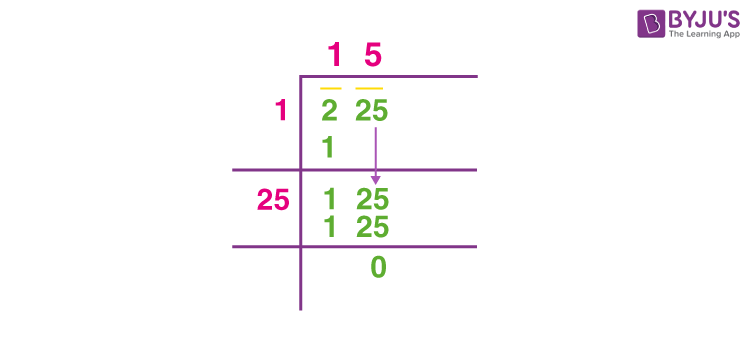
Subtracting to Get the Remainder
After forming the new divisor, subtract it from the part of the dividend that was not used in the previous step to get the remainder:
- Identify the part of the dividend that remains after using the largest number for the first pair.
- Subtract the product of the correct digit and the entire divisor from this remaining part of the dividend.
- The result of this subtraction is the new remainder.
Completing the Division
Continue the division process until all pairs of digits have been used:
- Repeat the steps of forming the new divisor, finding the correct digit for the quotient, subtracting to get the remainder, and bringing down the next pair of digits.
- Each time, update the quotient with the correct digit found and the remainder with the result of the subtraction.
- When there are no more pairs of digits to bring down, the division is complete.
- The final quotient obtained is the square root of the original number.
Result Interpretation
Once the division process is completed, interpret the final quotient obtained:
- The quotient represents the integer part of the square root of the original number.
- To find the decimal part or more precision, further steps involving approximation or more detailed division methods may be required.
- Verify the result by squaring the obtained quotient; the result should closely approximate the original number.
Example Problems
Let's go through some example problems to solidify your understanding of finding the square root of 225 using the division method. We will use detailed steps to ensure clarity.
Example 1: Square Root of 225
- Write the number 225 in pairs from right to left. Since 225 has three digits, we pair it as (2)(25).
- Find the largest number whose square is less than or equal to the first pair (2). The largest number is 1 (since 12 = 1).
- Write 1 as the first digit of the quotient. Subtract 12 from 2, which gives a remainder of 1. Bring down the next pair (25), making the new dividend 125.
- Double the quotient (1) and write it as the new divisor's first digit, giving us 2_.
- Find a digit to fill the blank in 2_ such that the product of the new divisor and this digit is less than or equal to 125. The digit is 5 because 25 × 5 = 125.
- Write 5 next to 1 in the quotient. Now, the quotient is 15. Subtract 125 from 125, resulting in a remainder of 0.
Therefore, the square root of 225 is 15.
Example 2: Square Root of 361
- Write the number 361 in pairs from right to left. We have (3)(61).
- Find the largest number whose square is less than or equal to the first pair (3). The largest number is 1 (since 12 = 1).
- Write 1 as the first digit of the quotient. Subtract 12 from 3, which gives a remainder of 2. Bring down the next pair (61), making the new dividend 261.
- Double the quotient (1) and write it as the new divisor's first digit, giving us 2_.
- Find a digit to fill the blank in 2_ such that the product of the new divisor and this digit is less than or equal to 261. The digit is 6 because 26 × 6 = 156.
- Write 6 next to 1 in the quotient. Now, the quotient is 16. Subtract 156 from 261, resulting in a remainder of 105.
- Double the quotient (16) to get 32_. Find the largest digit to place in the blank such that 32_ × _ is less than or equal to 105. The digit is 3, giving 323 × 3 = 969.
- Write 3 next to 16 in the quotient. The final quotient is 19, and the remainder is 0.
Therefore, the square root of 361 is 19.
Example 3: Square Root of 529
- Write the number 529 in pairs from right to left. We have (5)(29).
- Find the largest number whose square is less than or equal to the first pair (5). The largest number is 2 (since 22 = 4).
- Write 2 as the first digit of the quotient. Subtract 22 from 5, which gives a remainder of 1. Bring down the next pair (29), making the new dividend 129.
- Double the quotient (2) and write it as the new divisor's first digit, giving us 4_.
- Find a digit to fill the blank in 4_ such that the product of the new divisor and this digit is less than or equal to 129. The digit is 3 because 43 × 3 = 129.
- Write 3 next to 2 in the quotient. Now, the quotient is 23. Subtract 129 from 129, resulting in a remainder of 0.
Therefore, the square root of 529 is 23.
Example 4: Square Root of 784
- Write the number 784 in pairs from right to left. We have (7)(84).
- Find the largest number whose square is less than or equal to the first pair (7). The largest number is 2 (since 22 = 4).
- Write 2 as the first digit of the quotient. Subtract 22 from 7, which gives a remainder of 3. Bring down the next pair (84), making the new dividend 384.
- Double the quotient (2) and write it as the new divisor's first digit, giving us 4_.
- Find a digit to fill the blank in 4_ such that the product of the new divisor and this digit is less than or equal to 384. The digit is 8 because 48 × 8 = 384.
- Write 8 next to 2 in the quotient. Now, the quotient is 28. Subtract 384 from 384, resulting in a remainder of 0.
Therefore, the square root of 784 is 28.

Tips and Tricks
Mastering the division method for finding square roots can be made easier with a few helpful tips and tricks. Here are some strategies to enhance your efficiency and accuracy:
- Understand the Basics: Make sure you have a strong grasp of basic division and multiplication. This foundational knowledge is crucial for executing the division method correctly.
- Practice Pairing Digits: When pairing digits of the number you're working with, remember to start from the decimal point and pair digits to the left and right. This helps in setting up the problem accurately.
- Estimate and Adjust: Start with a reasonable estimate of the square root and refine it through iteration. This can save time and make the process more intuitive.
- Use Simplified Divisors: Simplify the process by using common shortcuts and patterns. For example, recognizing that the square of 5 ends in 25 can help in estimating parts of the quotient quickly.
- Check Your Work: Regularly verify your calculations at each step. Small mistakes can compound and lead to incorrect results, so double-checking can prevent errors.
- Stay Organized: Keep your work neat and organized. Writing out each step clearly helps in tracking your progress and making corrections easier if needed.
- Understand Remainders: When you get a remainder, remember to bring down the next pair of digits and continue the process until you reach the desired precision.
- Practice Regularly: Like any skill, regular practice improves proficiency. Work on a variety of problems to become comfortable with different scenarios and numbers.
- Use Technology: While practicing manually is important, using tools like calculators to verify your answers can build confidence and help you understand the process better.
With these tips, you'll find the division method for square roots to be a more manageable and even enjoyable process. Happy calculating!
Common Mistakes to Avoid
When calculating the square root of a number using the division method, it is important to be aware of common pitfalls to ensure accuracy. Here are some common mistakes to avoid:
- Incorrect Pairing of Digits: Ensure that the number is correctly divided into pairs starting from the decimal point and moving to the left for the integer part, and to the right for the fractional part. Misaligning these pairs can lead to incorrect results.
- Misplacing the Decimal Point: When extending the division to include decimal places, place the decimal point in the quotient correctly to maintain accuracy throughout the calculation.
- Incorrect Subtraction: During each step of the division process, double-check your subtraction to avoid carrying errors forward.
- Choosing Incorrect Quotient Digits: At each step, the quotient digit should be chosen such that the product of the new divisor and the chosen digit is less than or equal to the current dividend.
- Forgetting to Double the Quotient: When forming the new divisor, remember to double the current quotient before appending the next digit.
- Omitting Zeros in the Dividend: After reaching the end of the integer part, bring down pairs of zeros to continue the division process for finding decimal places.
By being mindful of these common mistakes, you can enhance the accuracy of your calculations when finding square roots using the division method.
Conclusion
Finding the square root of 225 using the division method is a systematic process that helps in understanding the fundamental concepts of square roots. By following the steps outlined, we can see how breaking down a number into manageable parts allows for accurate calculations.
Here's a summary of what we have learned:
- The square root of 225 is 15, as \(15 \times 15 = 225\).
- The division method involves pairing digits, finding suitable divisors, and iterating through division, multiplication, and subtraction until we reach the result.
- This method not only provides an accurate answer but also enhances our understanding of the properties of numbers and their roots.
- It's important to remember that practice with this method will make it easier to handle more complex numbers and improve overall mathematical proficiency.
Using the division method to find the square root of numbers, such as 225, illustrates the importance of step-by-step problem-solving techniques in mathematics. Whether you're preparing for exams or simply enhancing your mathematical skills, mastering this method is a valuable tool.
We hope this guide has been helpful and has provided a clear understanding of how to calculate the square root of 225 using the division method. Keep practicing, and soon you'll find that solving these types of problems becomes second nature.
Xem video hướng dẫn cách tìm căn bậc hai của 225 bằng phương pháp chia dài. Video giải thích chi tiết từng bước một cách rõ ràng và dễ hiểu.
Căn bậc hai của 225 √225= ? Bằng phương pháp chia dài
READ MORE:
Xem video hướng dẫn cách tìm căn bậc hai của 225 bằng phương pháp chia dài. Video giải thích chi tiết từng bước một cách rõ ràng và dễ hiểu.
√225 | Căn Bậc Hai của 225 bằng Phương Pháp Chia Dài | Toán Học




